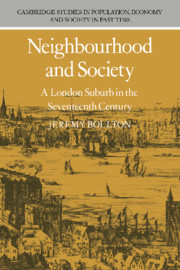Book contents
- Frontmatter
- Contents
- List of figures
- List of tables
- Preface
- Abbreviations
- 1 Introduction
- 2 The demographic background
- 3 Earning a living in early seventeenth-century Southwark
- 4 Wealth and social structure
- 5 Household structure and the household economy
- 6 Power, status and social mobility
- 7 Residential patterns and property ownership
- 8 The dynamics of a local community
- 9 Social relationships in the urban neighbourhood
- 10 The institutional structure of the neighbourhood
- 11 Conclusion: neighbourhood and society in seventeenth-century London
- Bibliography
- Index
7 - Residential patterns and property ownership
Published online by Cambridge University Press: 19 October 2009
- Frontmatter
- Contents
- List of figures
- List of tables
- Preface
- Abbreviations
- 1 Introduction
- 2 The demographic background
- 3 Earning a living in early seventeenth-century Southwark
- 4 Wealth and social structure
- 5 Household structure and the household economy
- 6 Power, status and social mobility
- 7 Residential patterns and property ownership
- 8 The dynamics of a local community
- 9 Social relationships in the urban neighbourhood
- 10 The institutional structure of the neighbourhood
- 11 Conclusion: neighbourhood and society in seventeenth-century London
- Bibliography
- Index
Summary
The urban environment of the Boroughside: a typology
Where people lived and who they lived next to are important topics in urban history because it is thought that such residential patterns reflected the social composition of urban areas and the ways in which individuals related to each other. Thus the social topography of the classic medieval town or city is said to have been distinguished by social mixing, where rich and poor lived in close physical proximity, perhaps living in streets dominated by one particular occupational group. This pattern underpinned a sense of community involvement, familiarity and belonging. Such social cohesion is thought to have broken down in the modern industrial city, marked as it was by physical segregation of social classes and distinguished by class rather than social solidarity, developed by people living close together with others of similar means rather than similar trades and crafts. Occupational or social zoning then, if it existed, might have exercised an important influence on urban social relations in the Boroughside. By reconstructing the residential distribution of wealth and occupations other information about neighbourly interaction can be placed in its proper context.
An examination of where Boroughside households were located might also allow us to infer something about how they lived.
- Type
- Chapter
- Information
- Publisher: Cambridge University PressPrint publication year: 1987

